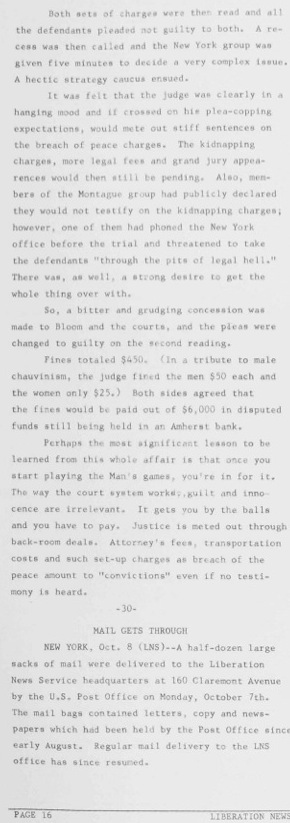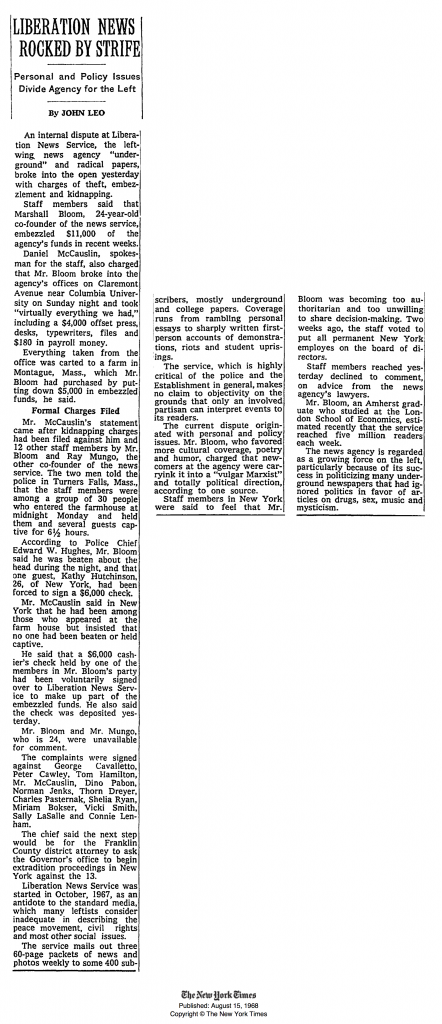Here’s how LNS covered the settlement of the charges resulting from the LNS split that summer:
Yearly Archives: 1968
1968: Accused of supporting “mass violence by urban guerrillas”
One New Left historian remembers Sheila in 1968 as a hard-core radical:
By 1968 important new elements were joining the ranks of the disillusioned. Business, much of it having assumed a partial and tentative membership in the liberal coalition, began to fear the inflation caused by the war. An antiwar group composed of Wall Street business executives, including Marriner Eccles, chair of the Federal Reserve Board under Presidents Roosevelt and Truman, took out an ad in the New York Times opposing the war on grounds it termed practical.
One antiwar activist, Sheila Ryan, attacked Eccles for owning mining operations that might conceivably benefit from the war’s end: evidently since he was not openly on the side of Hanoi and the National Liberation Front he had to be on Johnson’s. Ms. Ryan and some other members of the New Left had come to believe that only mass violence by urban guerrillas would end the evil sway of United States imperialism. Appearing to dislike Eccles and such liberals as Arthur Schlesinger more ardently than they did Johnson, they took as their hero the Argentine-Cuban revolutionary Ernesto “Ché” Guevara.
— In “Making Peace With the 60s“, by David Burner, Princeton University Press, 1996, page 208.
NY Times: “Liberation News Rocked by Strife”
Here’s how the New York Times covered the LNS split in August 1968:
(Available at NYTimes.com) (PDF Version)
And here was the follow-up piece the next day:
Leaders Should “Facilitate the Democratic Process”
Sheila was a passionate believer in democratic participation:
Others shared similar concerns. One was Sheila Ryan, a reporter for the Washington Free Press who began writing pieces for LNS in early 1968 after serving a harrowing six-month jail sentence for having sat in at the White House. Although hardly a cookie-cutter conformist, by the wild standards set by Bloom and Mungo, Ryan may have seemed culturally conservative. She had attended Catholic University, where she’d only rarely smoked marijuana (“because we didn’t have that much time to”), and she always knew that eventually she wanted to become a wife and a mother. Meanwhile, having steeped herself in the civil rights movement, Ryan was impressed with that struggle’s emphasis on democratic participation and consensus building. Her idea of a good leader, she said, was one “who would facilitate the democratic process and really allow people to come together and refine their ideas, and help the best ideas… emerge.” By contrast, she perceived an altogether different approach at LNS, whereby people clustered sycophantically around Bloom. Too often, the group’s accomplishments could be traced to a single individual’s inspiration, rather than the whole group’s collective effort.
— From Smoking Typewriters, John McMillian, Oxford University Press, 2011, page 147-148
1968-1970: Liberation News Service
From the middle of 1968 through early 1970, Sheila was a member of the collective that ran Liberation News Service, or LNS, which was an alternative press service for underground and new left publications.
For more information about LNS, you can see the brief overview in Wikipedia, an essay about “the new media” published by LNS in 1969, or Allen Young’s essay from 1990. The 1972 fundraising letter from Jack Newfield, Nat Hentoff, I.F. Stone, and William M. Kunstler to the New York Review of Books also details their impact.
Many of the LNS packets from August 1968 through 1977 are available at Archive.org. (The collection of packets from 1967 through 1968 was taken by LNS founders Bloom and Mungo and is now archived at the University of Massachusetts.) The LNS photo archive is held at NYU. The LNS research library is archived at Temple University in Philadelphia.
Joined LNS and Moved to New York
While Sheila was in jail in the fall of 1967, Liberation News Service was started in Washington D.C., and ended up sharing an office with the Washington Free Press:
Sheila Ryan[‘s] first encounter with LNS came as part of the Washington Free Press that shared space with LNS at 3 Thomas Circle as early as December 1967.
— From Living the Movement: Liberation News Service, Montague Farm, and the New Left, 1967-1981, Dissertation by Blake Slonecker
Following her release from jail in January 1968, Sheila wrote for both the Washington Free Press and LNS before moving to New York:
In early 1968, Sheila Ryan walked free from the Washington Women’s House of Detention, where she had been jailed for six months for her role in a White House sit-in to protest federal indifference to the civil rights crisis in Selma. The dislocation of her prison term had been jarring, yet her release provided an opportunity for her to make a clean break of affairs and to pursue a new direction in life. A longtime staffer at the Washington Free Press, Ryan at first returned to the participatory environment where she had come of age as an underground newsperson before her arrest. But she also began to write stories for Liberation News Service (LNS), and she quickly became enthralled by the prospect of speaking to a national audience. So when LNS packed up its equipment to leave Washington in July 1968, Ryan joined the organization in its move to New York.
— From A New Dawn for the New Left: Liberation News Service, Montague Farm, and the Long Sixties, by Blake Slonecker, Palgrave Macmillan, 2012.
Here’s another version of that story:
Just as LNS packed up its equipment to leave Washington for good, Sheila Ryan—a longtime staffer at the Washington Free Press who had published occasionally in LNS—decided to join them in their move to the Big Apple. Recently released from the Washington Women’s House of Detention—where she had been jailed for six months for her role in a White House sit-in to protest federal indifference to the civil rights crisis in Selma—Ryan was but one more coal thrown under the tinderbox of LNS’s new basement headquarters in Harlem.
— From Living the Movement: Liberation News Service, Montague Farm, and the New Left, 1967-1981, Dissertation by Blake Slonecker
February 1968: Trip to Cuba with SDS
In February, 1968, Sheila traveled to Cuba as part of an SDS delegation.
The trip was described in an FBI summary:








